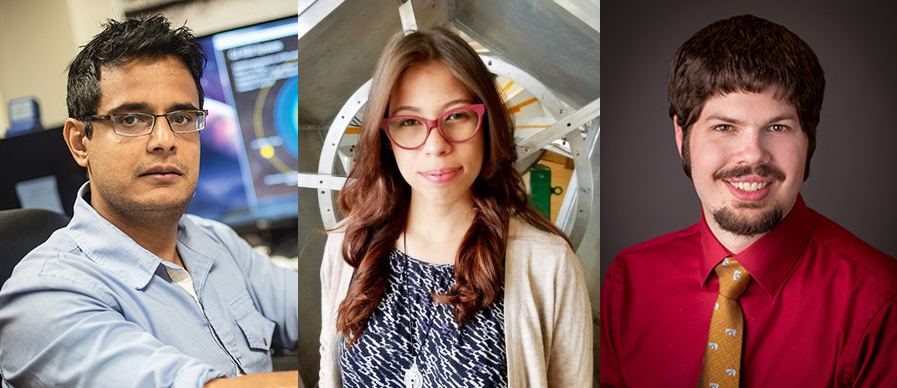New study examines how many moons an Earth-mass planet could host

A new study by a trio of physics researchers attempts to quantify how many moons the Earth, or an exoplanet with the mass of Earth orbiting a Sun-like star, could host in its orbit. Their findings: Anywhere from three to seven, depending on the moon’s mass.
The study, titled “Moon-packing around an Earth-mass planet”, was published in the August 1 online edition of the Monthly Notices of the Royal Astronomical Society. Lead author is Suman Satyal, adjunct assistant professor in physics at The University of Texas at Arlington. Satyal earned his Ph.D. in Physics from UTA in 2014.
Co-authors are Billy Quarles, who earned a Ph.D. in Physics from UTA in 2012 and is an assistant professor of astronomy and physics at Valdosta State University in Georgia; and Marialis Rosario-Franco, who earned a Ph.D. in Physics from UTA in 2021 and is an assistant teaching professor in astrophysical and planetary sciences at the University of Colorado at Boulder.
The Earth has a single moon and Mars has two, while neither Mercury nor Venus has any. But some of the Solar System’s giant planets, including Jupiter and Saturn, have dozens.
“Most planets in our Solar System contain multiple moons,” Satyal said. “Notably, giant planets like Jupiter and Saturn host approximately 80 moons. But the rocky planet Mars hosts two moons and Earth hosts one. These discrepancies could be tied to different formation mechanism and orbital evolution processes.”
In their study, the team used a series of N-body simulations, which approximate the motion of particles, to answer the question of how many moons could stably orbit Earth or an Earth-mass exoplanet.
“Our model ignores the gravitational effects of all the other planets within the Solar System,” Quarles said. “This is important when we look beyond the Solar System because there are a large number of systems with only a single planet candidate. There are currently two exomoon candidates, but they both orbit Jupiter-like planets at about one astronomical unit (approximately 150 million km or 93 million miles).”
The team’s study set the N-body simulation of multiple moons between the inner (Roche radius) and outer (Hill radius) stability limits for orbital bodies. In theory, a moon would be disintegrated by the host planet’s tidal forces if it were to orbit inside the Roche radius, and would escape the planet’s gravitational field if it were to orbit outside the Hill radius.
“However, the numerical studies have shown that the practical stability limits are within twice the Roche radius and about half of the Hill radius,” Satyal said. “Thus, we started the simulation of multiple moons (up to nine) between these reduced boundary limits and checked how many of them survived until the end of the simulation time.”

The team used moons with the mass of Ceres, Pluto, and Luna (Earth’s own moon) as prototype masses to compute orbital stability constraints. They found an upper limit of three Luna-mass moons, four Pluto-mass moons, and seven Ceres-mass moons which could orbit an exoplanet with the mass of Earth.
Even though approximately 5,000 known exoplanets have the probability of hosting tens of hundreds of exomoons, no confirmed exomoons have been detected yet. There are other observational constraints and limitations for such non-detection, Satyal said.
“For future observations, we believe that this work has great implications as it limits the existence of exomoons for Earth analogs in their respective habitable zones,” Satyal said. “With improvements in telescope sensitivity, such as the recently launched James Webb Space Telescope, we may be able to apply the transit method (measuring the depth in the starlight) to detect exomoons. Since it is possible for rocky planets, like Earth, to host more than one moon, it increases the probability of their detection. Such detection, and even a theoretical possibility, would beg the answer for the question regarding their formation scenario.”
“As the search for exomoons around Earth-like planets continues, our paper provides an upper limit to how many moons we should expect,” Quarles said. “If the observations suggest multiple exomoon candidates, some of those could be ruled out by either our current work or potentially through previous work performed by scientists at UTA. All four giant planets of the Solar System host multiple moons, so we may find exomoons to come in multiples as well.”
Quarles noted that the new study could have cultural significance with regard to depictions of exomoons in science fiction films and other media.
“While we were performing our investigation, I watched the movie Stargate and noticed that the extragalactic planet that the team travels to has three moons,” he said. “Many films illustrate the possibility of exomoons, such as Pandora from Avatar, or the forest moon Endor from Star Wars. Our study could help future works appear more astronomically accurate.”
--
The UTA College of Science, a Texas Tier One and Carnegie R1 research institution, is preparing the next generation of leaders in science through innovative education and hands-on research and offers programs in Biology, Chemistry & Biochemistry, Data Science, Earth & Environmental Sciences, Health Professions, Mathematics, Physics and Psychology. To support educational and research efforts visit the giving page, or if you're a prospective student interested in beginning your #MaverickScience journey visit our future students page.